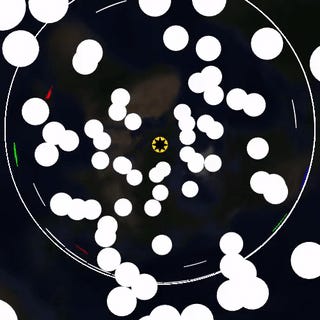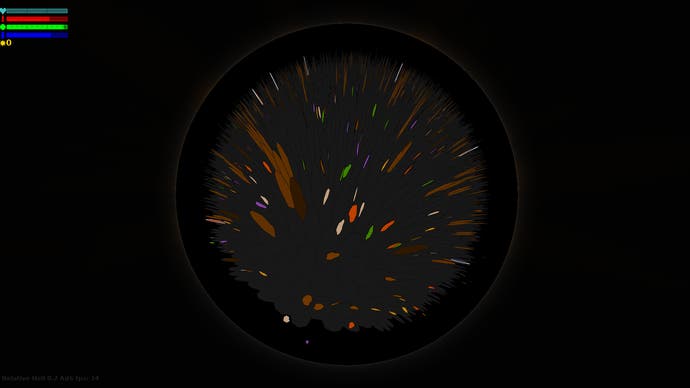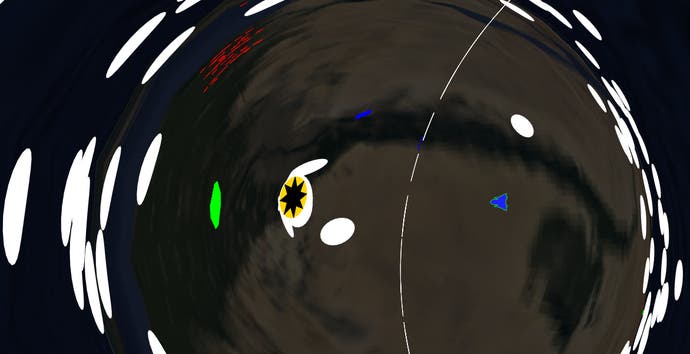Relative Hell is a shooter for people who think in four dimensions
Here¡¯s looking at Euclid.
In Atari's 1979-released coin-op game Asteroids, you play a dinky 2D starfighter blowing up drifting space rocks while fending off the occasional flying saucer. It can feel overwhelming - the play area wraps around itself, so you're constantly having to reorient when an asteroid coasts off screen and reappears opposite. But there's a fundamental orderliness to it. Each rock splits precisely into a pair of smaller, faster fragments when shot, which in turn split in two. Shooting wildly fills the screen with shrapnel, so you learn to be judicious, all the while swivelling and firing your rear booster to manage your ship's inertia.
Asteroids is, for me, one of the Perfect Games: simple props and rules, graceful execution, an organic, player-driven challenge factor accompanied by a cheeky variation on the Jaws theme. Zeno Rogue's homage-of-sorts Relative Hell is a touch less intuitive. It looks like Asteroids at a glance: a hardy little ship in the centre, blasting away at a throng of floating hazards. But that cleanly proportioned square of rogue boulders has become a clouded fisheye, not quite a circle, not quite a ball, with objects shrinking and stretching into bizarre, coloured fissures at the perimeter. Activating your ship's booster deforms the asteroids you're trying to navigate around - are they above or below you? What do "above" or "below" mean here anyway? - while your bullets travel in strange, broken arcs, swelling and dispersing as they travel.

Is it a glitch of some kind? You check the settings menu and it only adds to the confusion. One of the options is "View the future": this twists the whole asteroid field into a motley claymation spiral, as though each fleeting second in every rock's existence had been time-locked and grafted sloppily to the next. Another option gives each asteroid a separate numerical time signature. Then you hit "view the spacetime" and the play area becomes a 3D vortex of silhouettes, chasing each other down towards the barely-visible fleck of your vessel, a descent interrupted only when the simulation crashes.


This isn't your granddad's Asteroids - unless your granddad was astronomy professor and Einstein collaborator Willem de Sitter. He's one of the "discoverers" of de Sitter and anti-de Sitter space, which Relative Hell is based on. I don't have the faintest idea what these things are, really - I spent GSCE maths playing Golden Sun under my desk. But the crude approximation I'm working with is that they're mathematical models for the geometry of the universe, which treat time as a dimension alongside length, height and width. These models present the combined "spacetime" as distorted or curved, and that distortion is what we call gravity. De Sitter spacetime curves outward like a ball, while anti-de Sitter spacetime curves inward like a saddle.
Relative Hell is an attempt to convey all this using garden-variety 2D or 3D graphics and arcade mechanics, rather than impenetrable equations. It has two main modes. The Asteroids-esque mode takes place in anti-de Sitter spacetime, and features collectible resources together with mysterious gates to other areas, not that I've ever survived long enough to access them. The other mode is a bullet hell variant set in de Sitter space, where you dodge energy balls while trying to stay close to a star: let the latter slip off screen and it's gone forever, leaving you to coast along/through/under/above the surface of a spherical abyss.
Zeno Rogue seems to be on a mission to pump eccentric breeds of geometry into every genre on offer. Their other games include Nil Rider, in which you steer a unicycle up/down staircases that fold inwards/outwards relentlessly, and HyperRogue, a turn- and tile-based roguelike which looks like it takes place on the surface of an orb, but can also be rendered as a kind of evaporating, crystalline cave system. The idea of trying to "beat" any of these simulations fills me with horror, but I love the sheer confusion I feel as I heave and slide about Relative Hell's imponderable contours. When's the last time you had to really think about the behaviour of any given gamespace, beyond getting your head around this year's flavour of wall run?

